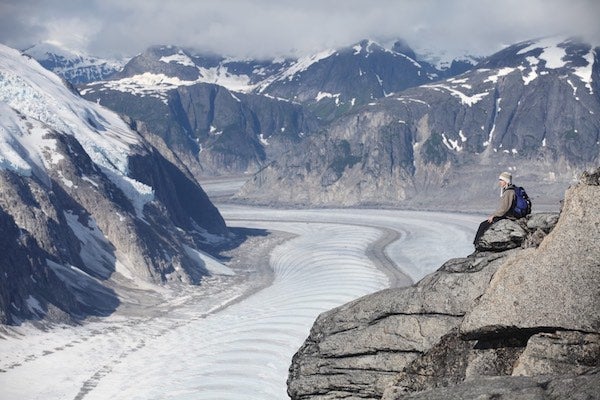This article was published in Scientific American’s former blog network and reflects the views of the author, not necessarily those of Scientific American
Every public lecture is like a stone thrown in a pond. The simple act of throwing that one stone creates a complex pattern. Waves propagate out, reflect from the banks of the pond, and interact with other waves. In the same way, one scientific lecture to an unknown audience can have unpredictable, far-reaching consequences. You never know who is listening or how they will respond to the metaphorical stone you’ve thrown in the pond.
In 2009, I gave a public lecture at Oregon State University in Corvallis. The title of my talk was: “How do we know human influences have affected global climate?” Outreach activities like this are part of my job. My research is funded by the federal government, and I need to be accountable in the public arena. It’s important to explain what my colleagues and I did with the funding we received, what we learned and why our findings matter to others.
My public presentations focus on “fingerprint” research. This work uses pattern recognition techniques to separate human from natural influences on climate. For over three decades, my colleagues and I have fingerprinted temperature, atmospheric moisture, ocean heat content, the height of the tropopause and many other aspects of the climate system. In each case, the observations are best explained by a large human fingerprint on global climate.
On supporting science journalism
If you're enjoying this article, consider supporting our award-winning journalism by subscribing. By purchasing a subscription you are helping to ensure the future of impactful stories about the discoveries and ideas shaping our world today.
At the end of every public talk, I speak about my own personal values. I point out that I’m not just a climate scientist—I’m also a rock-climber and mountaineer. I show pictures I’ve taken in the Alps, the Himalayas and the North Cascades. I explain that I’ve witnessed dramatic changes in these fragile, high-Alpine environments. Some of the Alpine glaciers I stood on 40 years ago are now vestiges of once-mighty rivers of ice. I tell the audience that these special places have value for me. We are all diminished if we lose them.
After my Corvallis lecture, a member of the audience responded to my pictures of changing glaciers. He suggested that I might want to visit the Juneau Icefield in Alaska. I made my first trip to the ice field in 2012; my fifth visit was just a few weeks ago. It’s an extraordinary, life-changing place. Since the pioneering work of Maynard Miller in the late 1940s, scientists have been monitoring the health of the Juneau Icefield’s glaciers. Every summer, 30–35 students from all over the world make the eight-week traverse of the ice field, hiking, skiing, and climbing from Juneau to British Columbia.
.jpg?w=600)
Field Camp 18 on the Juneau Icefield. Credit: Chip Duncan Duncan Entertainment Group
Along the way, the students are educated in one of the grandest classrooms in the world. They use ground-penetrating radar to image the interior of glaciers. GPS measurements allow them to study the flow rate of ice and changes to the surface height of glaciers. Isotope geochemistry provides insights into the sources of the water masses depositing snow on the ice field. The students even look at life on the ice field, attempting to understand how plant and insect communities respond to warming.
Expeditionary field science is not for the faint of heart. It’s hard work under challenging and sometimes uncomfortable conditions. It’s also critically important work. At a time when reality and facts are under constant attack, we need to know how and why our planet’s climate system is changing, and what these changes portend for the future of glaciers and ice sheets.
The students and scientific staff of the Juneau Icefield Research Program (JIRP) help to answer such questions. Since 2001, they’ve documented a decline of about 150 feet in the surface of the Gilkey Glacier. They’ve showed that in less than 70 years, a lake over four kilometers long formed at the lower end of the Gilkey. Participants in JIRP are witnesses to these and many other signs of change on the ice field. Their findings appear in scientific journals and are presented at conferences. Their stories and pictures propagate into the real world, just like those ripples from the stone thrown into the pond.
If I had unlimited power, I’d compel politicians who doubt the reality of human-caused climate change to spend a few days on the ice field. I’d respectfully request the doubters to reconcile their “global warming is a hoax” narrative with the pure and unadulterated curiosity of the students and faculty—the unquenchable thirst for advancing understanding of our strange and beautiful world. I’d require the naysayers to eat the same Spam and tinned food that the JIRP folks eat, to use the same outhouses precariously poised over icefalls, to sleep on the same wooden bunks, and to cheerfully accept forced withdrawal from cell phones, e-mail and tweeting. I’d ask proponents of a “business as usual” emissions scenarios to consider what it might mean to live in a world where the Juneau Icefield was a sad remnant of a once wild and spectacular place.

Student overlooking Gilkey Glacier at Field Camp 18 on Juneau Icefield. Credit: Chip Duncan Duncan Entertainment Group
Unfortunately, I don’t have the extraordinary power to persuade politicians to spend time in the real world. But I do have the power to keep throwing stones in the pond, and to keep speaking publicly about science, evidence and values. That stone-throwing power is not unique to one individual. It is shared by all who care about science, and by all who care about the kind of world we live in. Perhaps the ripples from these stones will ultimately change hearts, minds and attitudes. So, keep on making waves, as long as you can.